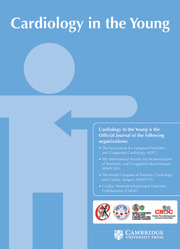No CrossRef data available.
Article contents
Successful embolisation of coronary artery fistulas with the Azur® CX peripheral coil system in three paediatric patients
Published online by Cambridge University Press: 24 February 2025
Abstract
Coronary artery fistulas are rare cardiac anomalies, often asymptomatic and frequently discovered incidentally during routine cardiac imaging. Transcatheter closure with coil embolisation is increasingly recognised as a preferable alternative to surgical intervention due to its lower complication rates. In this report, we present three paediatric cases in which coronary artery fistulas were successfully embolised using the Azur® CX Peripheral Coil System. This system demonstrates low-profile suitability for occluding highly tortuous vessels in children, enabling controlled coil delivery via a microcatheter. Its hydrogel-coated coils allow for expansion between gaps, making it highly effective as a minimally invasive treatment.
Keywords
- Type
- Brief Report
- Information
- Copyright
- © The Author(s), 2025. Published by Cambridge University Press



